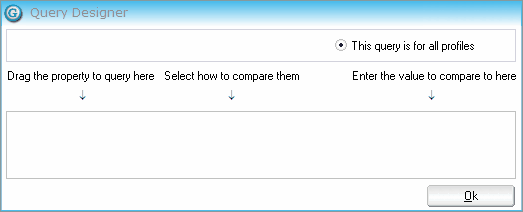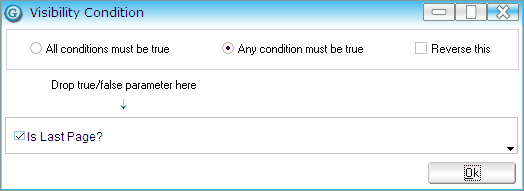Static Sections
Static section properties have three tabs:
Main
Section position
The default value is the position of the section within the report. Valid positions are:
- Report Header: Section will appear only once at the top of the report.
- Page Header: Section will appear once at the top of each page (after report header if one exists).
- Page Footer: Section will appear once at the bottom of each page.
- Report Footer: Section will appear only once at the bottom of the report (after page footer if one exists).
- Normal: Section will process and appear in the order it is placed on the design form.
Name
This defaults the section name, which can be changed by entering a new name and clicking the save icon. It is not a requirement to do so, but it is sometimes useful to give the section a name that describes it's purpose. This is particularly relevant for repeating sections. You can change the database name to something that is easier to recognise and describes the collection in common terms, such as All Customers, or All Inventory Items.
Content
This is only relevant for repeating sections - it displays the collection of the section.
Type
This section displays the type of object that is being displayed in relation to the collection (it will just display Company for sections that do not contain collections). For example, if the collection is myARControl:allCustomersCode, the type will be containing Customer.
Visibility Indicators
These options determine when/how the section appears on the report:
- Always: Select this option if you want the field to always appear on the report.
- Never: Select never if you want the field to never appear on the report.
- Based on a condition: Select
this if you want the field to display based on pre-defined a condition.
Click Set condition to add
the condition.
Visibility conditions are always based on true/false type parameters. When the Visibility Condition form is launched, the Available Fields Palette displays on form with the Parameter tab available. You can drag and drop one or more true/false parameters from a list of your pre-defined parameters onto the condition form. Select All conditions must be true or Any condition must be true as appropriate, and select Reverse this to reverse the logic to a false condition instead of a true condition.
Click the arrow icon to remove a parameter from the conditions. Click OK to close the form and update conditions.
Style
These properties relate to the physical format of fields added to the section. Most of the options are also available on the baseline toolbar.
 When these properties
are changed, the change only applies to fields added to the section subsequent
to the change. Any fields that exist in the section before editing the
style properties are not updated with the new style.
When these properties
are changed, the change only applies to fields added to the section subsequent
to the change. Any fields that exist in the section before editing the
style properties are not updated with the new style.
Other
This tab indicates whether there are any internal parameters in use, and if so, whether any of the values are determined when this section processes. Click Create and/or edit parameter settings to view the report parameters and options.
A list of all the parameters set up for the report display. In this example, the isUsingJC parameter value is the one determined by the section - this is because the query is in Edit mode instead of Define mode Edit the query for this parameter).
For any parameter, this feature enables you to either define a query that will determine the value of the parameter (for true/false parameters only), or to assign a database property to the parameter. The primary purpose of setting an internal parameter this way is so the value can be stored and printed on the report. The query or value assigned to the parameter can be set at a section level, so it can change depending on the section that is being processed when the report runs. The concept is similar to using a coding 'variable,' where the value of the variable can change depending on conditions.
 Using internal parameters
requires some advanced knowledge in report design.
Using internal parameters
requires some advanced knowledge in report design.
Example:
You want to print some text on the last page of the report and require some way of determining which is the last page. An internal parameter can be used to achieve this. First, set up a parameter that is not visible to the user at runtime, for example:

The Initial Value in this case does not matter because the value of the parameter will be determined by a query. If the section you want to add the last page text to is the report footer, access the section properties and click Create and/or edit parameter settings in the Other tab:

Click Define a query for this parameter to open the Query Designer:

In this example, you must use the pre-defined method: is page last in report. This method is coded to establish when the last page is printing for a report. Set up the query as:

This query sets the criteria that when the value of the is page lst in report method is selected, the value of the Is Last Page? parameter will also be true.
Add the text to the report footer using a label field, for example:

Now set a visibility condition on the field so that it will only print if the parameter Is Last Page? is selected.

When the report runs, the text THIS IS MY LAST PAGE: Message will only print on the last page.
